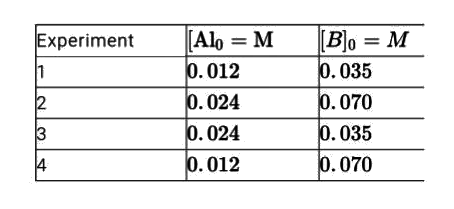Choose the law that corresponds to data shown for the reaction, A+B→ products.

A
Rate = k[B]3
B
Rate = k[B]4
C
Rate = k[A][B]3
D
Rate = k[A]3[B]
Text Solution
The correct Answer is:A
It is seen that, in experiments (3) and (2), [A] is constant and [B] is doubled and rates becomes 8 times, so order with respect to [B] = 3. In experiments (1) and (3), [B] is constant and [A] is doubled, but rate does not change, so order with respect to [A] = 0 Thus, rate = k[B]3
|
Topper's Solved these Questions
- CHEMICAL KINETICSBOOK - BITSAT GUIDECHAPTER - CHEMICAL KINETICSEXERCISE - BITSAT Archives
16 Videos
- CARBOXYLIC ACID AND DERIVATIVESBOOK - BITSAT GUIDECHAPTER - CARBOXYLIC ACID AND DERIVATIVESEXERCISE - All Questions
34 Videos
- CHEMICAL THERMODYNAMICSBOOK - BITSAT GUIDECHAPTER - CHEMICAL THERMODYNAMICSEXERCISE - BITSAT Archives
15 Videos
Similar Questions
Knowledge Check
Chose the law that corresponds to data shown for the following reaction, A+B→ products
 ARate =k[B]3BRate =k[B]4CRate =k[A][B]3DRate =k[A]3[B]
ARate =k[B]3BRate =k[B]4CRate =k[A][B]3DRate =k[A]3[B]Find the rate law that corresponds to the data shown for the following reaction?
 ARate=k[A]∘[B]3BRate=k[B]4CRate=k[A][B]3DRate=k[A]2[B]2
ARate=k[A]∘[B]3BRate=k[B]4CRate=k[A][B]3DRate=k[A]2[B]2According to law of mass action, for the reaction :2A+B→Products
ARate=k[A][B]BRate=k[A]2[B]CRate=k[A][B]2DRate=k[A]1/2[B]
Form the data given below for the reaction:A→B→ Products
the rate law expression is:
View SolutionConsider the following data for the reaction:
A+B→Products

Determine the order of reaction with respect to A and with respect to B and the overall order of the reaction.
View SolutionWhich of the following rate laws has an overall order of 0.5 for the reaction A + B + C → product?
View SolutionForm the data given below for the reaction:A→B→ Products
the rate law expression is:
View SolutionThe experimental rate law for a reaction
2A+2B→ Product, is
V∝CAC1/2B. If the concentration of both A and B are doubled the rate of reaction increases by a factor of
View Solution

